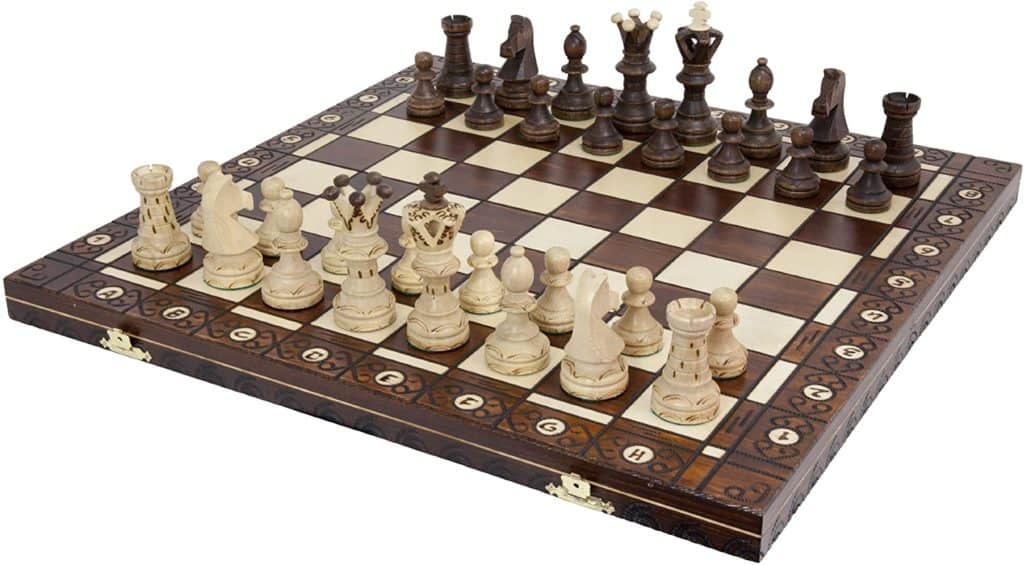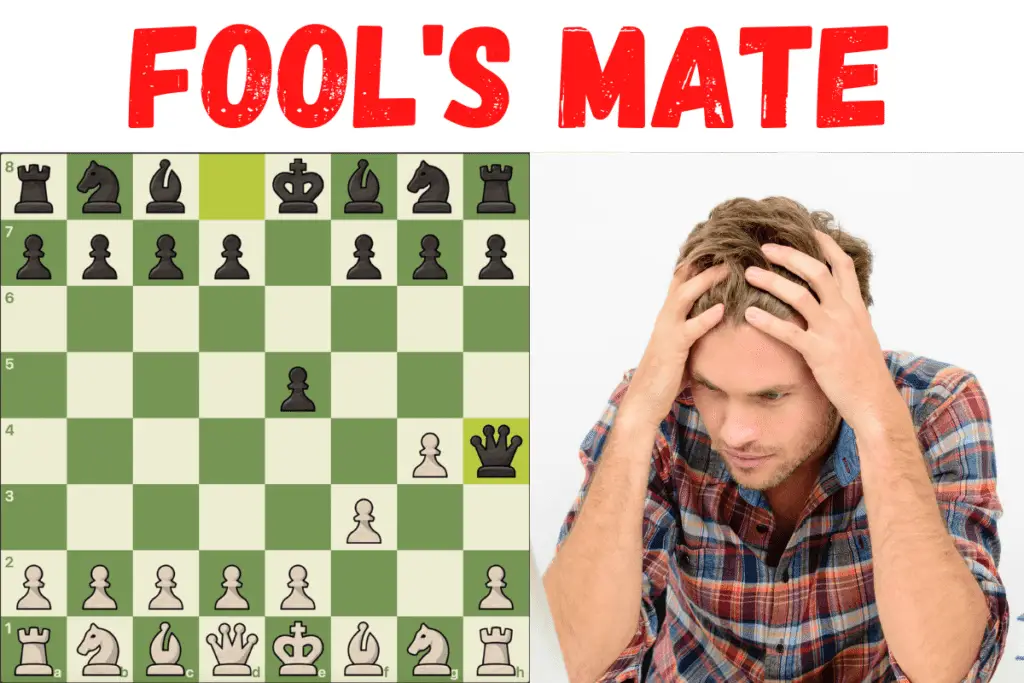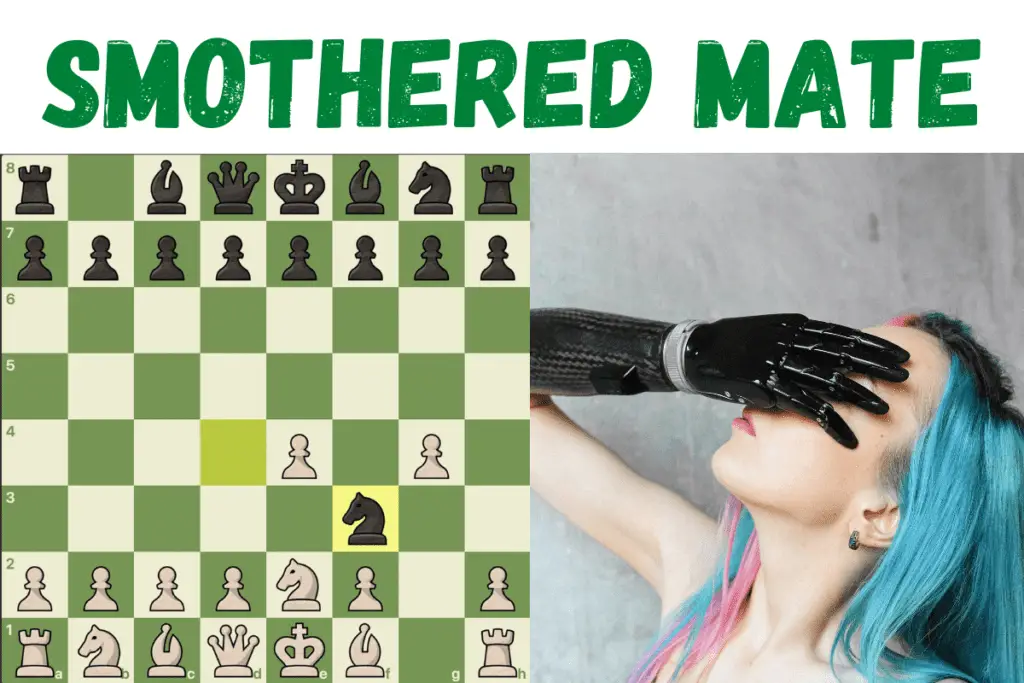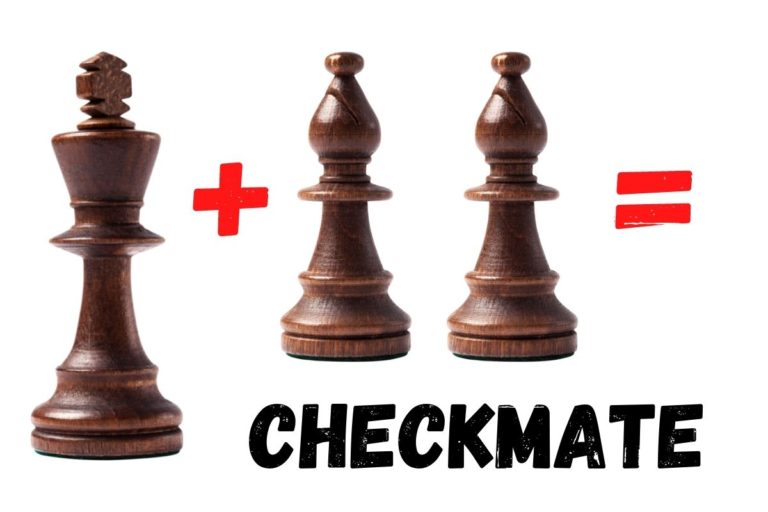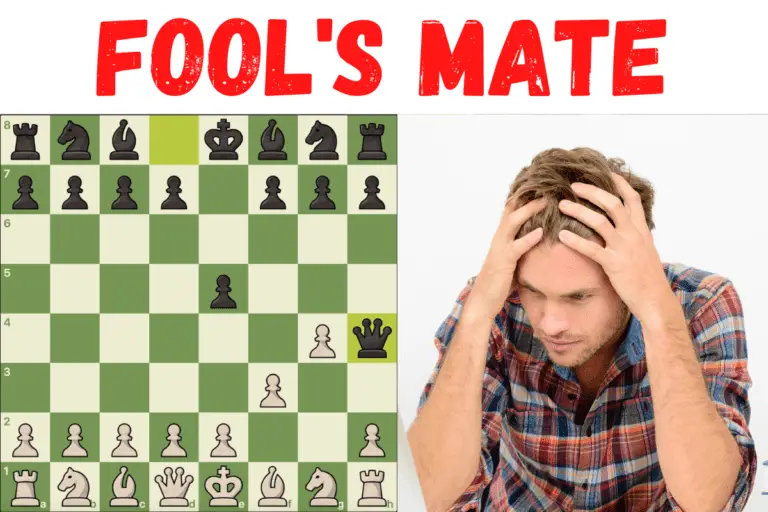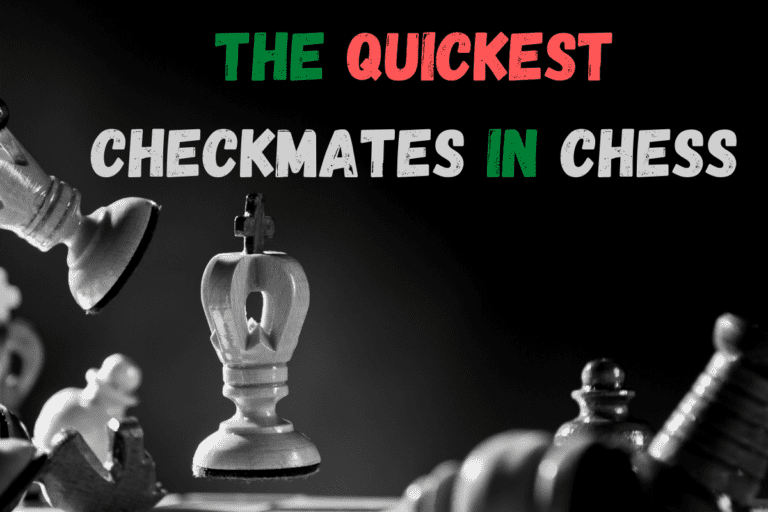Scholars Mate in Chess (What is it? – How to Win & How to Avoid)
⭐⭐⭐ Take 7 minutes to read and improve your chess game ➡️ : This article was first published on, and is Copyright of Chessquestions.com
The focus for the Scholar’s mate in chess is two very weak squares on a chessboard at the start of a game. Occupied by pawns, the f2 (white) and f7 (black) pawn squares are entirely unprotected in the starting position. It is possible for White to attack and achieve checkmate on this square within 4 moves of the chess game starting.
Scholars mate in chess is a potential 4 move checkmate for white pieces in chess, attacking the f7 square with a double threat with a bishop and a queen. The scholar’s mate targets the weakest square on the board which, left undefended, can lead to a rapid loss.
As one of the fastest checkmates on chess, the Scholars Four-move checkmate can be an impressive show of force of your chess pieces but does require the black pieces to be totally ignorant of the threat of one of the first checkmates you might learn as a beginner of chess.
This article will demonstrate the setup required to achieve the Scholar’s mate on the Black King. Whilst this checkmate pattern is possible in as few as four moves for the white pieces, it is rare that you may be able to achieve it, as the attack is quite obvious, however, there are ways to distract at the same time, and I will show an example of that too.
This article does refer to chess notation. 15 minutes spent learning chess notation will improve both your understanding and ability level in chess.
The 4 moves of White for Scholars Mate
These are 4 simple chess game moves, the opening moves for white, that anyone new to chess can learn and remember easily
Step By Step How to Win With Scholars Mate
The shortest possible scholars mate is only possible when playing the White pieces. Black can also win by attacking the f2 pawn square in the same manner, but this is not a pure Scholars mate in terms of a 4 move checkmate
- Your first move as white should be e4, that is, the King’s pawn moving forward two squares. This is the most common opening move inchess and many would also argue it is the best possible opening move for white of all. So, move that pawn 2 squares forward, and it is perfectly likly that black, as is most commong will respond by also moving his Kings pawn two squares forward closing the file as the pawns now stand off.
- Now move your white square bishop diagonally to the c4 square. Once there you will see a direct line back across the board to the black f7 pawn square. What happens next is critical to your Scholars mate attempt. We hope for black to play a limp pawn to d6, or bring the Knight out to c6. This is a failure to block your bishops path to f7 weak square.
- Now you need to move your queen to either f3, or h5. I would suggest f3 as this is less commital and arguably less obvious, and your opponent may get blinded by the possible attack on your Queen by moving the Knight to d4. The key here is black not being familiar with the threat and in turn trying to attack your queen. they can do this whether you are on f3 or h5 by moving thier Knights to either d4 or f6. When they do, you can make the final move required and complete the Scholar’s mate.
- Capture the Black pawn on f7 using either your Bishop or Queen to perform the Scholar’s mate checkmate final manouvre. Whilst the King was defending the pawn on f7, because of the double threat on that square and whichever piece has moved there being protected by the other, the King can not capture on f7, the game is lost for black and you are the victor.
Scholars Mate Examples
Here you can see the four moves and set up to win in the shortest possible time using the Scholars mate checkmates in chess. It seems unthinkable that black would miss this attack and that their third move would not in some way protect the f7 square but it can happen more often than you might imagine.
In this example, famously used in the Queen’s Gambit Mini-Series on Netflix, Black has missed defending their f7 square with a focus on attacking the Queen with the Knight, leaving open the Queen to f7 Mate move.
Another 4 move version, again attacking that f7 square with black providing the opportunity to succeed by attacking the queen with the Knight instead of blocking the paths to the f7 square
Queen Sacrifice for an f7 Checkmate
This is an almost irresistible trap, whereby White sacrifices its Queen to complete a checkmate on the f7 square. A kind of elongated Scholar’s Mate here.
Quite simply the white bishop is positioned as it would be for the Scholar’s mate, but instead of Queen development for white it has used the Knight to f3 which is commonly attacked by the black bishop to g4. The key here is to move the knight forward to attack f7, which will most likely be totally missed as Black can only see the fact you have hung the queen on the back rank. He will often be unable to resist and not notice your double attack on the f7 square leaving you a mate in 1 position.
Scholars Mate Defense
Now you know how to perform the Scholar’s Mate you’ll identify immediately if your opponent is targeting the squares required to try to get you in that position. So you might want to learn some moves to avoid it. After this, take a look as I explain how to crush the Scholars mate and counter-attack to win quickly if someone attempts the Scholar’s Mate on you
4 Ways to Avoid Losing to Scholar’s Mate
- Develop your Queen to the 2nd row e7 square– This protects the pawn on f7, and unless your opponent wants a very early Queen trade, and lose thier bishop into the bargain, it is very unlikely they will continue the tactic
- Develop your pawn on the g file. One of the strongest moves you can make in defending against the Schiolars mate, you are also developing material on a white square an opening up the fiancetto line for your black square bishop
- Develop your Queen to the f6 square in front of f7. – here there are two possibilities, depending on were the opponent has position thier queen for the attack. If they too have the quuen on the f file they will most likely avoid a trade of queens and move
- Develop your Kingside Knight to h6. This is generally considered a poor move if not necessary as you don’t really want your Knights out on the flanks and giving up space and control in the center of the board bit it does protect the f7 square if the Scholar’s Mate threat is present. There is one exception on low level games where this may work very much in your favour. See the section below
How to Attack Scholars Mate Being Played Against You & Win the Queen
A couple of points before I go any further here, before I get into Knight to h6 defense and attempted Queen trap strategy.
- It is unlikely that you will see scholars mate outside of a novice game of chess
- I wouldn’t advise trying scholars mate on someone better rated than yourself
- This attack on a scholars mate attempt is obvious and may be spotted, averted and leaving you in a slightly worse position
- but if it works, you win the white Queen
So let’s go
You know when you are playing black pieces, if your opponents goes e4 and immediately beings the Queen to h5 or Bishop to c4, that they are setting up the Scholars mate.
Although advised against earlier, you can try Kings Knight to h6. This move protects the f7 square and prevents the Scholars mate.
Now, when you make this move, white should abort the mission and remove the Queen because if they do not, you are one simple move away from capturing it and gaining a huge advantage in the game and begin your own mating attack thanks to whites weakness.
So unless White moves to a check position (Don’t worry you may still get a chance), your very next move should be…..
Bishop to g5 – The white queen will be trapped in an awful position, a defenseless position and lost, and in fact, in many cases, with players retiring after losing a Queen early, you may have just averted a 4-move checkmate and within 2 moves, won the game yourself!! Awesome!
Is Fool’s Mate the Same as Scholar’s Mate?
It is often the case that someone thinks that Scholars mate is the quickest checkmate in chess and just another name for Fool’s mate, but they are two different things entirely, with Scholar’s mate revolving around the weak pawns on the f2 and f7 squares and Fool’s Mate being a 2-move checkmate
6 Scholars Mate Facts
Let´s get everything straight, after reading this post, you should NEVER lose a game of chess to Scholar’s mate again. You know your f7 or f2 square is vulnerable, so you should be able to protect it in the opening you play from now on. By the same token, you should be aware of your opponent’s vulnerability and always be looking to expose it if they leave the square unguarded pre-castling.
- The Scholar’s mate was first named in a text by Francis Beale in 1656 who may have drawn his inspiration from the adaptiation of Italian chess player Gioachino Greco
- In Italy the Scholar’s Mate is known as the Barber’s Mate
- In English it has also been known as the Schoolboy’s Mate, or even Blitzkreig!
- Scholars mate was featured in the very first game we say in the TV Series Queen’s Gambit
- It is the most famous 4 move checkmate in chess
- Everyone loses to Scholar’s mate at some point
ChessQuestions.com is a participant in the Amazon Services LLC Associates Program, an affiliate advertising program designed to provide a means for sites to earn advertising fees by advertising and linking to Amazon.com, Amazon.co.uk or Amazon.ca
You Want to be a BETTER CHESS PLAYER but Don’t Know Where to Start
Everyone knows that chess is a challenging game. Even the best players in the world continue to learn and improve their skills.
Garry Kasparov’s Masterclass Chess Course is the perfect solution for you. In this course, Garry will teach you his favorite openings and advanced tactics, so that you can develop your instincts and philosophy as a chess player. With over 20 hours of video lessons, this course is guaranteed to make you a stronger player.
Alternatively, you can sign up for a Masterclass with Gary Kasparov for just $16 per month. And get access to all other masterclass courses at the same time, from Movie Making, Music recording, Cooking, and Health & Wellbeing.
Chess Set
This is a superb Wegiel Handmade European Ambassador Chess Set which is stored inside the board itself. Super high quality, it looks fantastic too
- Wooden 21 Inch Beech & Birch Board With Felt Base
- Carved Hornbeam & Sycamore Wood Chess Pieces
- Compartment Inside The Board To Store Each Piece
